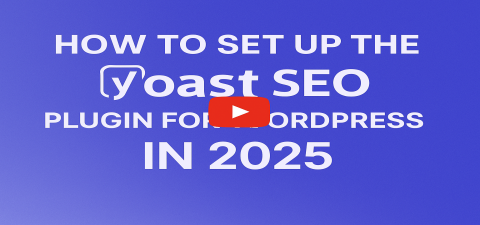
How to Write SEO Blog Posts That Rank (Step-by-Step Guide with AI)
Hey there! In today's online world, a super well-put-together blog post is a real game-changer. It helps bring folks to your site, shows you know your stuff, and even turns casual readers into loyal customers. But with so much content popping up every single day, how do you make sure your posts shine and hit those top spots on Google? Well, it's all about mixing smart SEO tricks with the awesome power of Artificial Intelligence!
This easy-to-follow guide will walk you through creating blog posts that not only rank high but also truly connect with your audience. Plus, we'll show you how AI tools can make your life so much easier!
Step 1: Define Your Content Strategy
Before you even think about keywords or fancy AI tools, you've gotta have a clear game plan for your content. This first step is super important because it makes sure every single piece you write has a purpose and fits right into your bigger business goals.
Know Your Audience: Who are you trying to chat with? What worries them, what questions do they have, what gets them excited? Try creating "buyer personas" to get a crystal-clear picture.
Find Your Niche & What You're Great At: What special something can you bring to the table? Stick to topics where you're an expert and can genuinely offer cool insights.
Set Clear Goals: What do you want your blog posts to actually do? (Like, get more visitors, grab some leads, boost your brand's name, or sell more stuff!)
Match Content to Their Journey: Think about where your audience is in their journey – are they just learning, considering options, or ready to buy? Plan content for each stage.
Step 2: Do Keyword Research (AI + SEO Tools)
Keyword research is like the secret sauce of SEO. It helps you figure out exactly what your audience is typing into search bars. And guess what? AI tools can seriously kick this process up a notch!
Brainstorm Initial Keywords: Start with some big, general topics related to what you do.
Use Regular SEO Tools: Grab tools like Semrush, Ahrefs, or Google Keyword Planner. They're great for finding related keywords, longer phrases, how many people search for them, and how tough the competition is.
Let AI Help You Expand: AI tools are awesome for suggesting similar words, related phrases, and even spotting new trends! Just pop your initial keywords into an AI writing assistant or a special AI keyword tool to get a huge list of relevant terms and ideas.
Check Out the Competition: See what keywords your rivals are ranking for. This can help you find cool opportunities you might have missed.
Pick Your Best Keywords: Aim for keywords that get a decent amount of searches but aren't super competitive. Also, think about why people are searching (just looking for info, trying to find something specific, ready to buy, or doing some research).
Step 3: Create an AI-Enhanced Content Brief
Think of a content brief as your blog post's blueprint. It keeps everything consistent and makes sure you hit all your SEO targets. And the best part? AI can help you whip up these detailed briefs in no time!
Main & Supporting Keywords: Clearly state the main keyword you're going after, plus any other keywords you want to include.
Who It's For & Why: Remind yourself who the post is for and what problem it's going to solve.
SERP Analysis & Competitor Peek: Jot down what the top-ranking articles for your keyword are doing. What's working for them? Where are they falling short? AI tools can quickly sum up the main points from those top articles.
Structure & Headings: Outline the main sections and subheadings. AI can suggest a logical flow and common questions related to your topic, helping you build your article just right.
Key Points & FAQs: List all the must-have info and questions your post needs to answer. AI can even generate common FAQs based on your topic and audience.
Tone & Style: Decide how you want your post to sound (e.g., informative, super chill, really authoritative).
Call to Action (CTA): What do you want readers to do after they finish reading?
Step 4: Write the First Draft with AI
Alright, this is where AI truly shines and makes content creation way faster!
Feed It Your Brief: Just give your detailed content brief to an AI writing assistant (like Gemini, ChatGPT, Jasper, or Copy.ai).
Generate Section by Section: Instead of trying to get the whole post at once, ask the AI to write one section at a time based on your headings. This gives you way more control and usually leads to better quality stuff.
Tweak Your Prompts: If the first try isn't quite right, just adjust your prompts. Be super specific about what info you need, the tone, and how long you want it to be.
Fact-Check & Double-Check: Seriously, AI can sometimes make stuff up! Always, always, always fact-check any stats, claims, or info the AI gives you. Don't just trust it blindly for accuracy.
Add Your Own Flavor: While AI can churn out text, it doesn't have your unique experiences or thoughts. Make sure to sprinkle in your brand's special voice, some personal stories, and deeper insights to make the content feel real and engaging.
Step 5: Optimize the Blog Post for SEO
Once you've got a solid first draft, it's time to fine-tune it for search engines.
On-Page SEO:
Keyword Placement: Naturally weave your main and secondary keywords into your title, meta description, intro, headings, and body. No stuffing keywords in there, please!
Title Tag & Meta Description: Create catchy, keyword-rich title tags (keep 'em under 60 characters) and meta descriptions (under 160 characters) that make people want to click!
URL Structure: Make your URLs short, clear, and keyword-friendly.
Internal Linking: Link to other relevant pages on your site. This helps people explore more and spreads the SEO love around.
External Linking: Link out to credible external sources. It adds value and shows you're legit.
Image Optimisation: Use descriptive alt text for your images, squish them down so they load fast, and use relevant keywords in their file names.
Readability & User Experience (UX):
Short Paragraphs & Sentences: Break up those big chunks of text!
Subheadings & Bullet Points: Use these to make your post super easy to skim.
White Space: Make sure there's plenty of empty space for a clean, inviting look.
Mobile Responsiveness: Your blog post needs to look and work great on phones and tablets too!
Proofread & Edit: Always check for grammar, spelling, punctuation oopsies, and awkward sentences. A polished piece just looks more professional.
Step 6: Publish & Promote
Your awesome, optimised blog post is ready to go out into the world!
Publish It! Get your post uploaded to your content management system (CMS).
Share on Social Media: Shout out your new post across all your social media channels.
Email Marketing: Pop the blog post into your next newsletter or send a special email to your subscribers.
Content Syndication: Think about sharing your content on platforms like Medium or LinkedIn (just make sure to use those canonical tags!). This can help you reach even more people.
Outreach: If your post mentioned other experts or businesses, let them know! They might just share it with their followers.
Step 7: Track & Improve
SEO is like a never-ending journey! Keeping an eye on your post's performance is key to making it even better over time.
Google Analytics: Keep tabs on how much organic traffic you're getting, how quickly people leave, how long they stay on the page, and if they're converting.
Google Search Console: Check your keyword rankings, how many times your post shows up, how many clicks it gets, and if there are any weird errors.
Heatmaps & Session Recordings: Tools like Hotjar can show you how people are interacting with your content. Pretty cool, right?
Analyze & Adapt: Look at your data and figure out what's working and what's not. Then, go back and update older posts, add new info, refresh keywords, and improve those internal links.
Final Thoughts
Writing SEO blog posts that really rank is a mix of smart planning, digging deep for info, crafting engaging words, and clever optimization. By bringing AI tools into your process, you can seriously speed things up, letting you create tons of high-quality, SEO-friendly content. Just remember, AI is an amazing helper, but your human touch – your expertise, your unique voice, and your smart thinking – is still totally essential for content that truly makes an impact. Happy writing!





